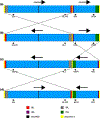Emerging Concepts in Congenital Cytomegalovirus
- PMID: 35909155
- PMCID: PMC11635406
- DOI: 10.1542/peds.2021-055896
Emerging Concepts in Congenital Cytomegalovirus
Abstract
Over a century of research has focused on improving our understanding of congenital cytomegalovirus (cCMV), yet it remains the most common congenital infection in the United States, affecting 3 to 6 per 1000 live born infants each year. Pregnancies affected by cCMV are at a heightened risk of spontaneous abortion and intrauterine fetal demise. Neonates born with cCMV are also at substantial risk for long-term neurodevelopmental sequelae and disability, including sensorineural hearing loss, even those born without clinically apparent disease. Considerable progress has been made in recent years in study of the epidemiology and transmission of cCMV, developing better diagnostic strategies, implementing newborn screening programs, improving therapeutics, and launching vaccine trials. In this article, we review recent developments in the understanding of the virology and immunobiology of cytomegalovirus. We further discuss how this knowledge informs our understanding of the pathophysiology of cCMV and directs strategies aimed at improving outcomes and quality of life for congenitally infected children. We also provide an update on the epidemiology of cCMV in the United States, evolving scientific understanding of maternal-fetal transmission, enhanced screening approaches, and recognition of neonatal and long-term sequelae. Finally, we review the current landscape of pediatric cCMV research and provide recommendations for novel and high-priority areas for future investigation.
Copyright © 2022 by the American Academy of Pediatrics.
Conflict of interest statement
Figures



References
-
- Ho M The history of cytomegalovirus and its diseases. Medical microbiology and immunology. 2008;197(2):65–73. - PubMed
-
- Fellah T, Sibiude J, Vauloup-Fellous C, et al. Evolution of awareness and knowledge of congenital cytomegalovirus infection among health care providers in France between 2011 and 2018. J Clin Virol 2020;129:104335. - PubMed
Publication types
MeSH terms
Grants and funding
LinkOut - more resources
Full Text Sources
Medical

